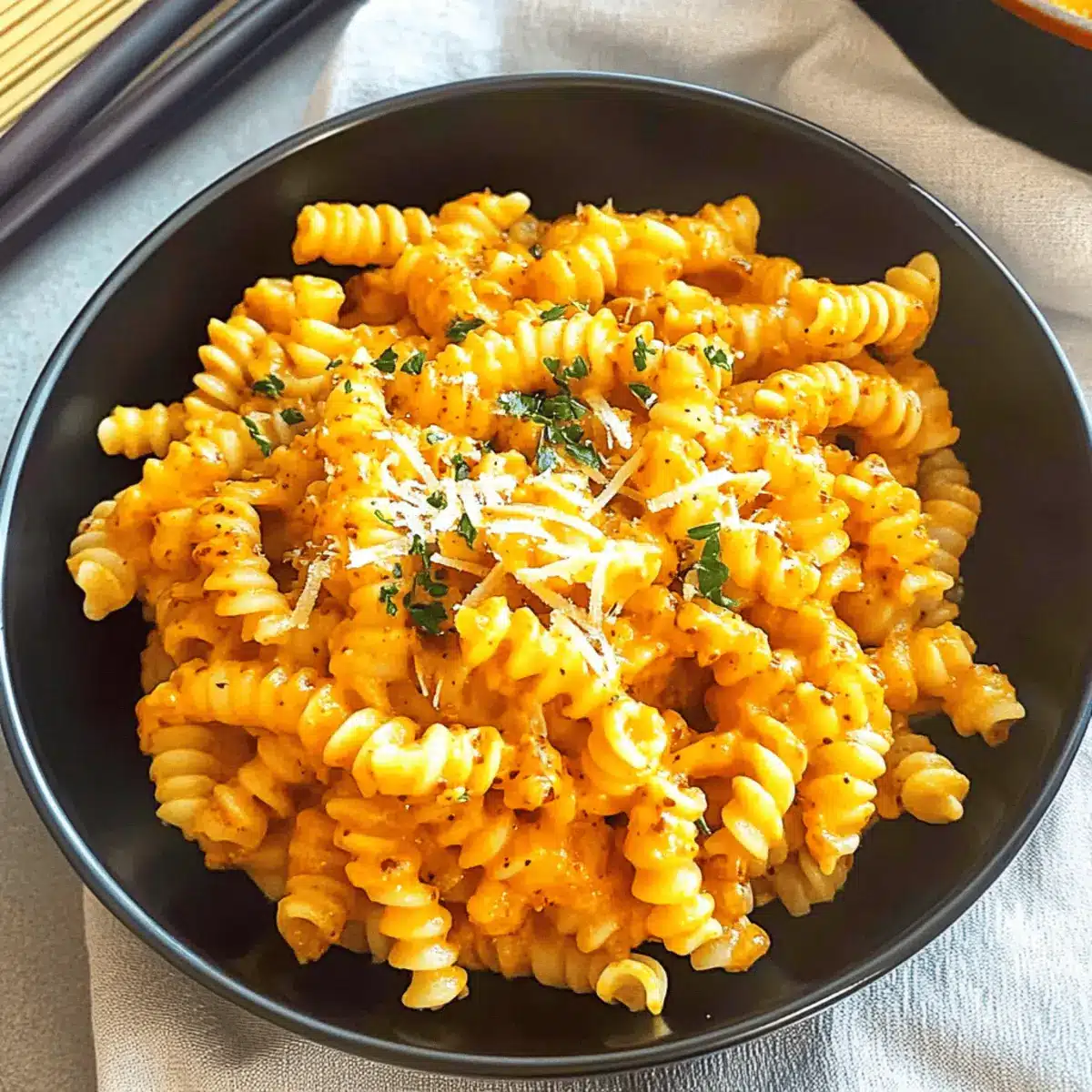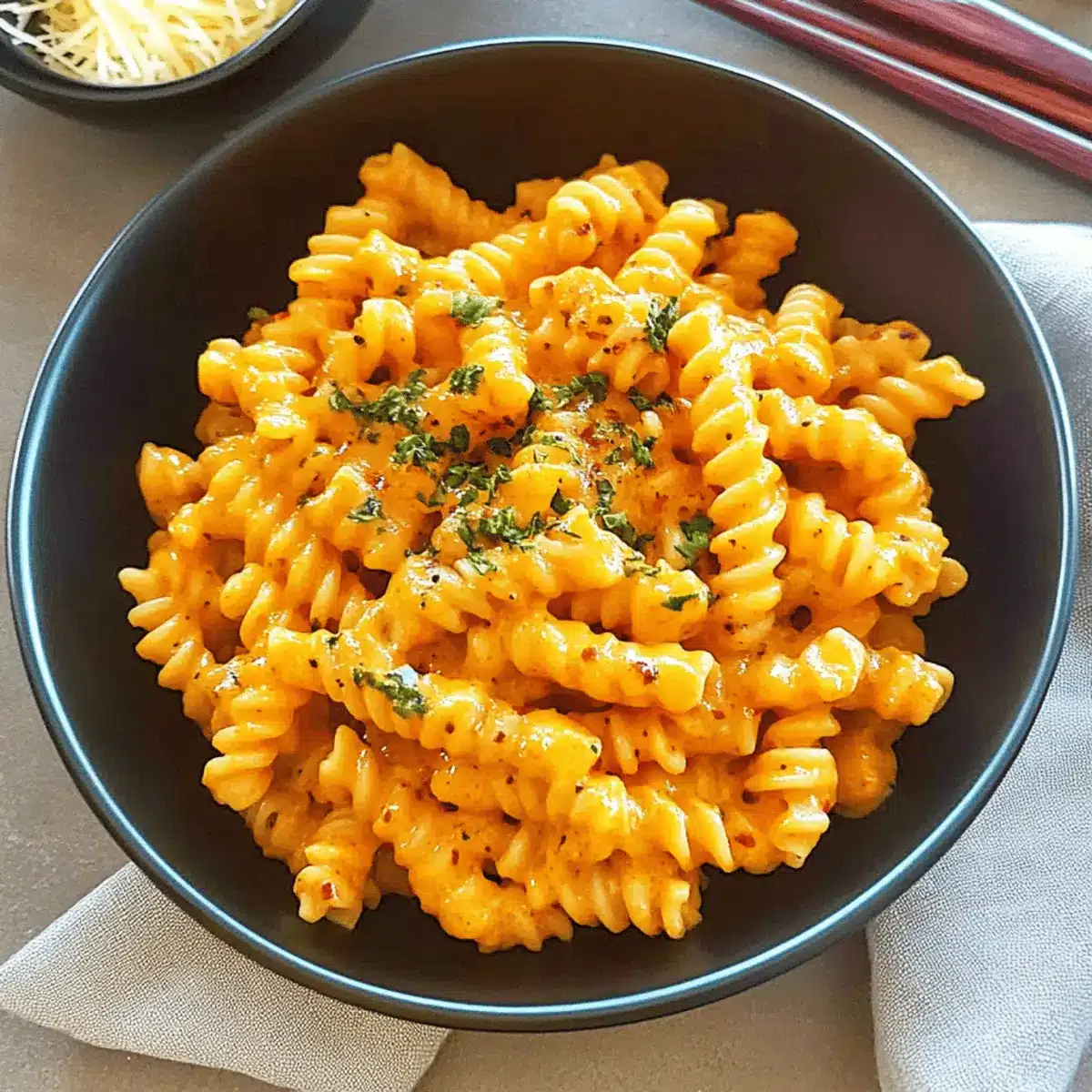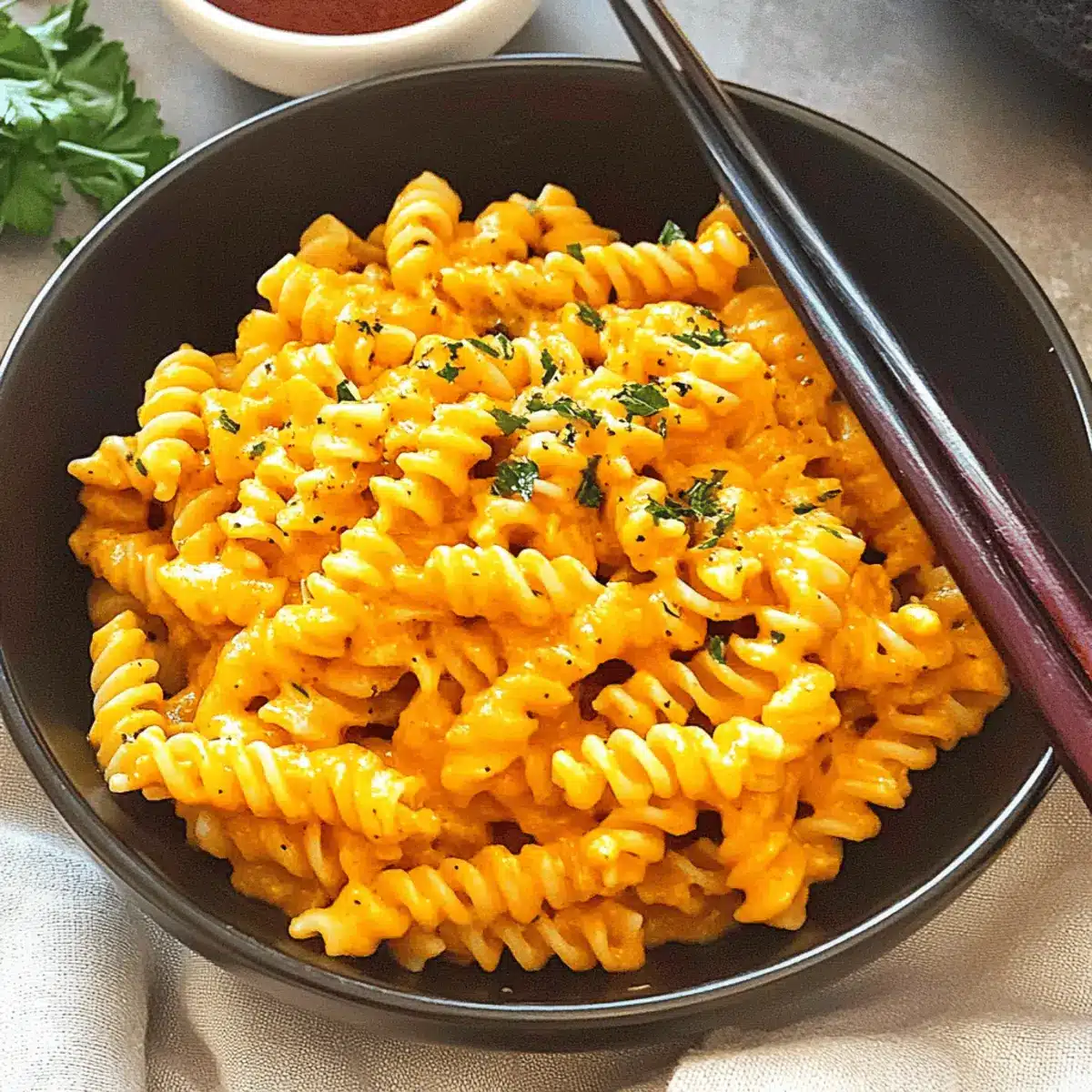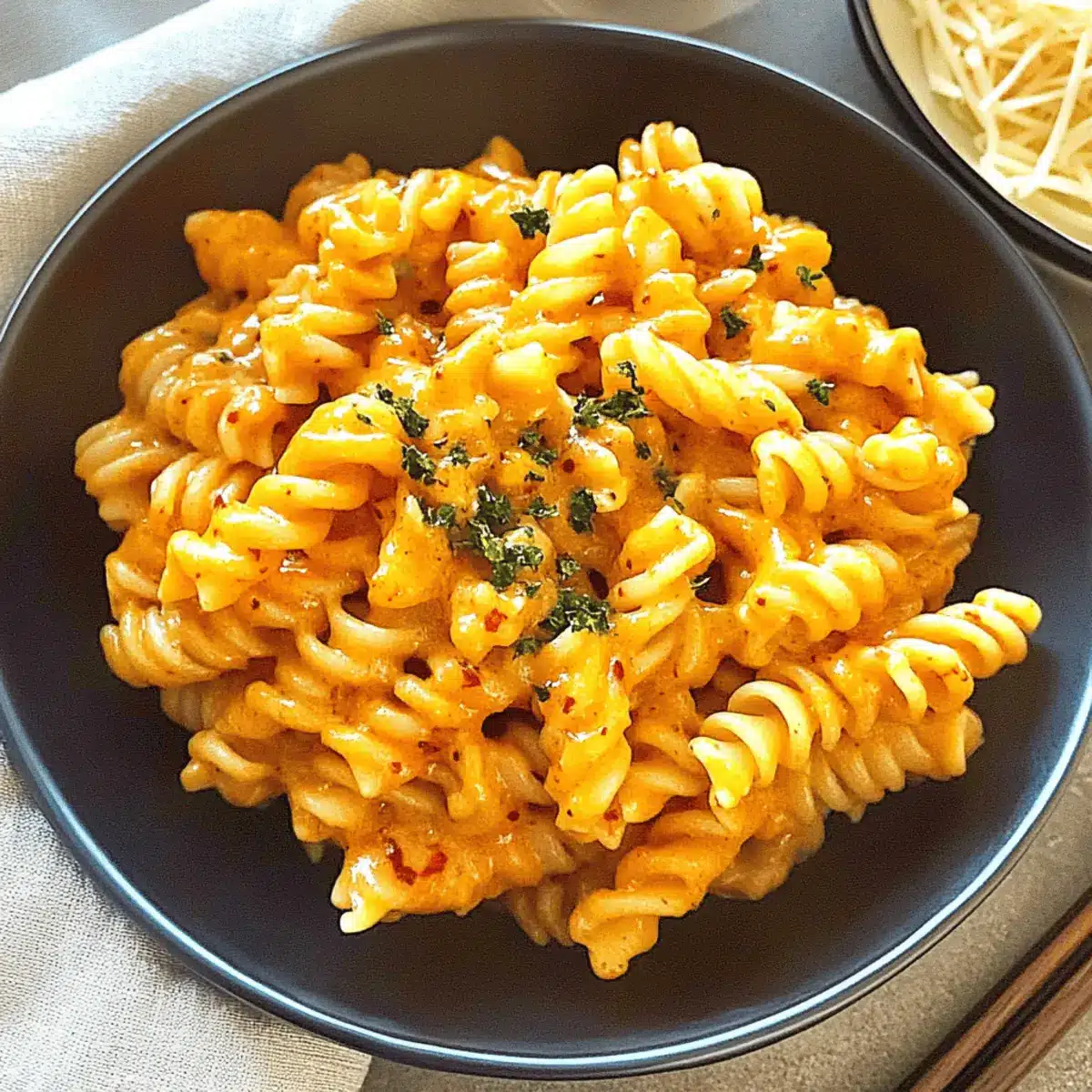As I stirred together the creamy sauce, a wave of excitement washed over me—it was time for something new on my dinner table. Enter Gochujang Pasta, a dish that delicately fuses Korean flavors with the comfort of classic Italian fare. Ready in under 15 minutes, this recipe is a lifesaver for busy weeknights or last-minute gatherings. The irresistible combination of spicy-sweet gochujang and creamy goodness makes this dish not just quick to prepare, but also a satisfying and nutritious twist on traditional pasta. Whether you’re hosting friends or simply treating yourself, you’ll find this dish to be an adventurous delight that promises to impress. Curious about how to elevate your pasta game with a unique flavor profile? Let’s dive in!

Why Try Gochujang Pasta Today?
Bold and Flavorful: This Gochujang Pasta is a taste explosion, combining spicy Korean gochujang with rich creaminess for a delightful dish.
Quick and Easy: Whipping this up takes only 15 minutes, making it perfect for those busy weeknights.
Versatile Ingredients: Customize by adding your favorite vegetables or proteins such as tofu or grilled chicken, ensuring everyone at the table is satisfied.
Healthy Twist: With options for gluten-free and vegan adaptations, this recipe suits a variety of dietary needs.
Crowd Pleaser: Impress guests with something unique; it’s a delicious conversation starter at any gathering! Explore other delightful options like Baked Feta Pasta for more inspiration!
Gochujang Pasta Ingredients
• A simple list to create this flavorful dish!
For the Pasta
- 8 oz Dry Pasta – Use Fusilli Corti Bucati or your favorite shape for a satisfying base.
For the Sauce
- 2 tablespoons Gochujang – This Korean chili paste delivers that signature spicy and umami flavor; check for gluten-free brands if needed.
- 3 cloves Garlic – Minced or pressed garlic adds aromatic depth to the creamy sauce.
- 4 tablespoons Salted Butter – Provides richness and enhances the overall flavor of the dish.
- 2 tablespoons Olive Oil – Aids in sautéing garlic and laying the foundation for the sauce.
- ½ cup Shredded Parmesan or Cheddar Cheese – Imparts creaminess to balance the spice; substitute with vegan cheese for a dairy-free option.
- ½ cup Heavy Cream – Creates a luscious texture in the sauce; can be swapped for plant-based milk for a vegan version.
- ½ teaspoon Freshly Ground Black Pepper (optional) – Enhances flavor, adding a subtle kick.
- 2 teaspoons Chopped Parsley (optional garnish) – Offers freshness and a burst of color to your finished dish.
Step‑by‑Step Instructions for Gochujang Pasta
Step 1: Cook the Pasta
Begin by bringing a large pot of salted water to a rolling boil over high heat. Once boiling, add 8 oz of dry pasta and cook according to package instructions for about 7-12 minutes until al dente. Stir occasionally to prevent sticking. When done, drain the pasta in a colander and set aside, reserving a bit of the pasta water for later use.
Step 2: Sauté the Garlic
In a large sauté pan, melt 4 tablespoons of salted butter and add 2 tablespoons of olive oil over medium heat. Allow the mixture to heat until it shimmers, then add 3 cloves of minced garlic. Cook for 30-60 seconds, stirring gently, until the garlic is fragrant and just begins to turn golden—be careful not to burn it as that can create bitterness.
Step 3: Create the Sauce
Stir in 2 tablespoons of gochujang and ½ cup of heavy cream into the sauté pan, allowing the flavors to meld. Raise the heat slightly and continue to cook for 1-2 minutes, stirring constantly until the sauce thickens and becomes creamy. If it thickens too much, add a splash of the reserved pasta water to reach your desired consistency.
Step 4: Add the Cheese
Once the sauce has thickened, reduce the heat to low and incorporate ½ cup of shredded Parmesan or cheddar cheese into the mix, stirring until melted and evenly distributed. This creamy addition enhances the sauce and balances the spice from the gochujang, creating a rich, flavorful base for your Gochujang Pasta.
Step 5: Combine Pasta and Sauce
Add the drained pasta to the sauté pan and gently toss to coat the noodles evenly in the creamy gochujang sauce. Make sure every piece of pasta is well-covered, as this will infuse it with that delightful spicy-sweet flavor. Continue cooking for an additional minute to allow the pasta to heat through.
Step 6: Serve and Garnish
Transfer the Gochujang Pasta to serving plates or bowls while it’s still hot. For an extra touch of freshness, sprinkle 2 teaspoons of chopped parsley over the top as a garnish. This adds vibrant color and a burst of herbaceous flavor, making your dish visually appealing and deliciously inviting.

Gochujang Pasta Variations & Substitutions
Feel free to tweak this delightful dish to suit your taste buds and dietary needs—there’s no wrong way to enjoy Gochujang Pasta!
- Gluten-Free: Simply use gluten-free pasta brands to suit your dietary restrictions while retaining the dish’s wonderful flavors.
- Vegan: Replace heavy cream with coconut milk or a plant-based cream, and opt for nutritional yeast instead of cheese for a creamy vegan experience.
- Extra Veggies: Boost your nutrition by adding sautéed zucchini, bell peppers, or spinach; they add color and texture, making every bite an adventure.
- Spicy Kick: If you enjoy it spicier, consider adding more gochujang or some red pepper flakes for an extra heat level that excites your palate.
- Cheesy Goodness: Experiment with different types of cheese like feta or gouda, each offering a unique twist to the dish’s richness.
- Asian Noodle Twist: Swap traditional pasta for ramen or udon noodles for a fun texture switch that still pairs beautifully with the creamy sauce.
- Protein Boost: Add grilled chicken, shrimp, or marinated tofu to enhance the protein content, transforming this pasta into a satisfying main course.
- Creamy Alternative: For a lighter version, use half-and-half or a dairy-free yogurt substitute to create a luscious sauce without the heaviness.
As you explore these variations, let your culinary creativity shine! And if you’re itching for more delicious pasta ideas, check out the warm and inviting Parmesan Chicken Pasta or the comforting One Pot Pasta. Your taste buds will thank you!
Expert Tips for Gochujang Pasta
- Watch the Garlic: Avoid burning garlic in the sauté pan. If it turns too dark, your sauce may taste bitter.
- Customize with Veggies: Enhance texture and nutrition by adding sautéed or roasted vegetables like bell peppers or zucchini before incorporating the sauce.
- Protein Pairing: Boost the dish with grilled chicken, shrimp, tofu, or ground beef for a hearty meal that pleases everyone at the table.
- Vegan Adaptation: To make Gochujang Pasta vegan, replace heavy cream and cheese with plant-based alternatives like coconut milk and nutritional yeast.
- Stir, Don’t Toss: Gently stir the pasta when combining it with the sauce to ensure even coverage without breaking the noodles.
How to Store and Freeze Gochujang Pasta
Fridge: Store leftover Gochujang Pasta in an airtight container and refrigerate for up to 5 days. Be sure the pasta is cooled before sealing to maintain freshness.
Freezer: For longer storage, freeze the pasta in a freezer-safe container for up to 2 months. To prevent freezer burn, wrap tightly in plastic wrap before placing it in the container.
Reheating: Reheat the Gochujang Pasta in a microwave or on the stovetop, adding a splash of water or cream to loosen the sauce as needed. Stir well and heat until warmed through.
Avoid Repeated Refreezing: It’s best not to refreeze the pasta after thawing, as it may affect the texture and flavor. Enjoy it fresh for a delightful meal!
What to Serve with Gochujang Pasta
Ready to create a delightful dining experience to complement your creamy, spicy masterpiece?
- Garlic Bread: The crispy, buttery perfection of garlic bread offers a satisfying crunch that pairs wonderfully with the creamy sauce.
- Steamed Broccoli: Lightly steamed broccoli adds vibrant color and freshness to your meal, enhancing its nutritional value while balancing the rich flavors.
- Korean-Style Pickles: Tangy and slightly sweet, these pickles introduce a refreshing contrast to the savory Gochujang Pasta, elevating each bite.
- Crisp Salad: A simple green salad with a zesty vinaigrette introduces a crisp texture and bright flavor, creating great contrast against the creamy pasta.
- Roasted Sweet Potatoes: The natural sweetness of roasted sweet potatoes complements the spiciness of the pasta, adding heartiness to your meal.
- Sake or Soju: For beverage pairings, sip on sake or soju to embrace the Korean influence, enhancing the culinary experience.
- Chocolate Mousse: End on a sweet note by indulging in luxurious chocolate mousse, providing a rich finish to your flavorful feast!
- Fruit Sorbet: Light and refreshing, a fruit sorbet cleanses the palate and adds a delightful fruity touch after the spicy pasta.
Make Ahead Options
These Gochujang Pasta components are perfect for meal prep, saving you time on those busy weeknights! You can cook the pasta and sauté the garlic (steps 1 and 2) up to 24 hours in advance; simply refrigerate them separately in airtight containers. When you’re ready to enjoy your meal, quickly combine the sautéed ingredients with the gochujang and cream (step 3), then add the cheese before tossing with the pasta. This method ensures each bite remains flavorful and creamy, just as delicious as when freshly made! Remember, the key to maintaining the dish’s quality is to store components separately until it’s time to heat and serve.

Gochujang Pasta Recipe FAQs
How do I choose the right gochujang?
Look for a brand that is rich in color with a thick texture. It should have a nice balance of heat and sweetness. Always check the label if you require gluten-free options, as some may contain wheat ingredients.
What’s the best way to store leftover Gochujang Pasta?
Store leftovers in an airtight container in the refrigerator for up to 5 days. Be sure the pasta is cooled before sealing to maintain its freshness. When ready to eat, reheat using a splash of water or cream to help rehydrate that creamy sauce!
Can I freeze Gochujang Pasta?
Absolutely! Freeze the Gochujang Pasta in a freezer-safe container for up to 2 months. To prevent freezer burn, tightly wrap the pasta in plastic wrap before placing it in the container. When ready to enjoy, thaw overnight in the refrigerator and reheat gently on the stovetop.
What can I do if my sauce turns out too thick?
If your sauce is too thick, simply add a splash of the reserved pasta water or additional cream while reheating. Stir well until you reach your desired consistency. It’s a great way to revive the dish and keep that creamy texture!
Are there any dietary considerations I should be aware of with this recipe?
If you’re serving people with allergies, it’s important to note that this dish contains dairy and may contain gluten, depending on your chosen pasta and gochujang. For a vegan twist, substitute heavy cream and cheese with plant-based alternatives. Always check ingredient labels for allergens.
What if I have leftover gochujang?
That’s a great question! You can use leftover gochujang to spice up stir-fries, marinades, or soups. It also works wonderfully in salad dressings or as a dipping sauce for steamed vegetables or dumplings! Enjoy experimenting!

Creamy Gochujang Pasta: A Spicy, Comforting Delight
Ingredients
Equipment
Method
- Bring a large pot of salted water to a boil and cook the dry pasta according to package instructions until al dente, then drain and set aside.
- In a large sauté pan, melt the salted butter with olive oil over medium heat and add minced garlic, cooking until fragrant.
- Stir in the gochujang and heavy cream, cooking until the sauce thickens, adding reserved pasta water if necessary.
- Reduce heat to low, add shredded cheese, and stir until melted to enhance the creamy sauce.
- Add the drained pasta to the sauté pan and toss to coat evenly with the sauce.
- Transfer to serving plates and garnish with chopped parsley before serving.

Leave a Reply